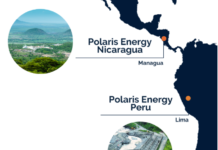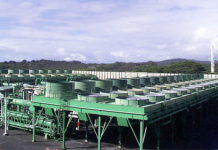by Debra Fiakas CFA
 |
| Olkaria III Geothermal Power Plant, Kenya |
Shares of geothermal power developer and utility Ormat Technologies (ORA: NYSE) are trading at 24.7 times the consensus estimate for 2013. That seems pricey on the surface, but the stock is down from a 52-week high of $22.24. The stock gaps up and down with regularity, suggesting ORA is a battle ground for bulls and bears. The fact that the 50-day moving average price continues to descend toward the longer-term 200-day average, hints that maybe the bears are now holding sway.
This is one of my favorite companies in the Geothermal Group of our Mothers of Invention Index for energy innovators. Ormat operates geothermal utilities in the U.S. and around the world. Electricity sales represent about three-quarters of the Ormat’s sales. The company also provides engineering and procurement services for third-party energy developers and sells power plant equipment using its proprietary technologies.
Ormat has been profitable for a while, so I was a surprised to see a negative trailing earnings number in a popular financial database. Taking a closer look, I found that Ormat operations are as strong as ever. Gross profit margin in the first half of 2012 was at a record 30.5%. Operating margin also hit a record 19.7%, making it clear management is not squandering the extra profits on unnecessary administrative spending.
Investors need to look carefully at the tax line on Ormat’s profit and loss statement. It is messy. In 2010, the company reported a benefit and last year the tax provision was a whopping $48.5 million. The thing is the tax bill as shown on the income statement is just “reported” taxes. Investors have to read the fine print in management’s comments and footnotes to figure out the real tax bill. Alternatively, you can just turn the page to the cash flow statement where the CFO makes all sorts of additions back to net income to come clean on real-time cash expenses. Turns out $38.1 million out of the $48.5 million tax bill reported in the year 2011 was not paid in cash at all and just sequestered away on the balance sheet for a future date.
Just in case that made sense to you, let me add a bit of complexity to the story. Last year in 2010, Ormat reported a tax benefit of $1.1 million. However, it really paid $10.1 million in taxes using the company’s hard earned cash. Investors can expect more of this sort of uneven reporting of the tax obligation. It is just part and parcel of Ormat’s business model that leads to deferred tax assets and liabilities.
Given the noisiness in Ormat’s reported net income, it is best to watch cash flow from operations (CFO). CFO weeds out the ups and downs associated with the accounting treatment for taxes, and delivers a better read than reported net income on what Ormat is delivering to shareholders. Ormat has converted 28.0% of sales or $417 million into operating cash since the beginning of 2009. Ormat needs every penny for its capital spending program. Capital expenditures over the same time period totaled $953.8 million. The gap has been filled in by debt, most of which is associated with constructing and equipping Ormat’s geothermal plants.
The debt-to-equity ratio at the end of June 2012 was about 1.00, which is on par with the average debt load in the electric utility industry. Since then Ormat floated another $310 million in debt to finance the Olkaria III power plant complex in Kenya. The first two phases of the project have been profitable operations since 2000 and 2009, respectively. The success of the first two projects should mitigate concerns investors have about the increased leverage. There are risks inherent in geothermal energy production mostly surrounding the unpredictability of Mother Nature, but the Olkaria area has been tested.
Fortunately for people like you and me who are willing to sacrifice a bit of time to read management’s notes, there are plenty of financial reporters and investors who may have only looked rising debt or the red ink in 2011 and decided Ormat is a losing, risky operation. The stock has traded up and down in the months since the year 2011 results were reported, but has yet to make a recovery to the late 2010 and early 2011 period when the stock was near $30 per share. Given the shrinkage in valuations across all sectors it is too much to expect a return to ORA’s glory days in 2008 when the price topped $40 per share.
A study of Ormat’s price chart could provide insight into a good entry point for a position in a strong company with solid cash earnings. ORA offers a dividend yield of 0.90% as a bit of icing on the cake.
Debra Fiakas is the Managing Director of Crystal Equity Research, an alternative research resource on small capitalization companies in selected industries.
Neither the author of the Small Cap Strategist web log, Crystal Equity Research nor its affiliates have a beneficial interest in the companies mentioned herein. ORA is included in the Geothermal Group of Crystal Equity Research’s Electric Earth Index.







